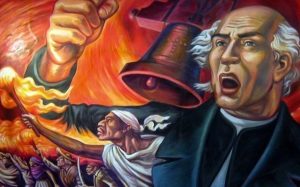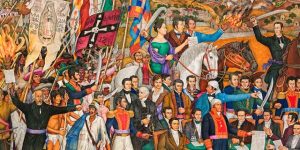Mexico’s Independence
The Mexican War of Independence (Guerra de Independencia de México) was an armed conflict, and the culmination of a political and social process which ended the rule of Spain in 1821 in the territory of New Spain. The war had its antecedent in Napoleon’s French invasion of Spain in 1808.
The war of independence began on September 16, 1810, when Father Miguel Hidalgo gave the so-called “Cry of Dolores” and ends on September 27, 1821 with the entrance of the army of the Three Guarantees, headed by Agustín de Iturbide and Vicente Guerrero, to the City of Mexico.
The French Revolutionary Wars and the conquests of Napoleon deeply influenced events in New Spain. In 1808, Charles IV and Ferdinand VII were forced to abdicate in favor of the French Emperor. The same year, the ayuntamiento (city council) of Mexico City claimed sovereignty in the absence of the legitimate king. That led to a coup against the viceroy; when it was suppressed, the leaders of the movement were jailed.
Despite the defeat in Mexico City, small groups of rebels met in other cities of New Spain to raise movements against colonial rule. In 1810, after being discovered, Querétaro conspirators chose to take up arms on September 16th in the company of peasants and indigenous inhabitants of Dolores (Guanajuato), who were called to action by the secular Catholic priest Miguel Hidalgo.
In January, Hidalgo and the insurgent army suffered a defeat near Guadalajara. They headed north toward the United States, but were ambushed along the way. Hidalgo was captured and executed. Another priest named José Morelos continued the revolutionary efforts until his execution in 1815. After the defeat of Morelos, the movement survived as a guerrilla war under the leadership of Vicente Guerrero. By 1820, the few rebel groups survived most notably in the Sierra Madre del Sur and Veracruz.
The reinstatement of the liberal Constitution of Cadiz in 1820 caused a change of mind among the elite groups who had supported Spanish rule. Monarchist Creoles affected by the constitution decided to support the independence of New Spain. Agustín de Iturbide led the military arm of the conspirators and in early 1821 he met Vicente Guerrero. Both proclaimed the Plan of Iguala, which called for the union of all insurgent factions and was supported by both the aristocracy and clergy of New Spain. It called for monarchy in an independent Mexico. Finally, the independence of Mexico was achieved on September 27, 1821.
The mainland of New Spain was organized as the Mexican Empire. This Catholic monarchy changed to a federal republic in 1823, due to internal conflicts and the separation of Central America from Mexico.
After some Spanish reconquest attempts, including the expedition of Isidro Barradas in 1829, Spain under the rule of Isabella II recognized the independence of Mexico in 1836.
Every 15 September at around 11 p.m., the President of Mexico stands on the balcony of the National Palace in Mexico City and rings the same bell that Hidalgo rang in 1810, which was moved to the National Palace. The President then recites a shout of patriotism (a Grito Mexicano) based upon the “Grito de Dolores”, with the names of the important heroes of the Mexican War of Independence who were there on that historic day.
Shout of Patriotism:
Spanish
¡Mexicanos!
¡Vivan los héroes que nos dieron patria!
¡Viva Hidalgo!
¡Viva Morelos!
¡Viva Josefa Ortiz de Domínguez!
¡Viva Allende!
¡Viva Aldama y Matamoros!
¡Viva la Independencia Nacional!
¡Viva México! ¡Viva México! ¡Viva México!
English
Mexicans!
Long live the heroes who gave us our homeland!
Long live Hidalgo!
Long live Morelos!
Long live Josefa Ortiz de Domínguez!
Long live Allende!
Long live Aldama and Matamoros!
Long live the nation’s independence!
Long Live Mexico! Long Live Mexico! Long Live Mexico!




